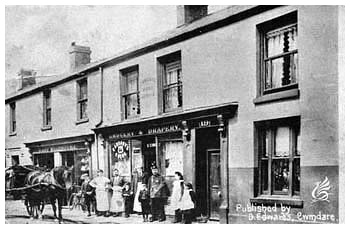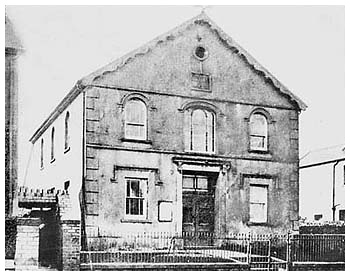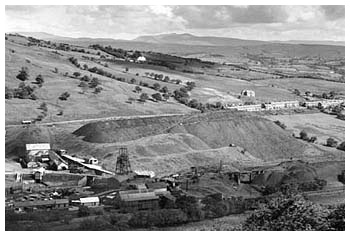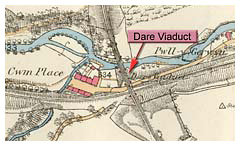
| Cwmdare | |
Before the opening of the collieries and the establishment of the village of Cwmdare in the 1850's, Cwmdare had been an area of scattered farmhouses and holdings. A number of these farms still survive, including Bwllfa, Nantmelin and Tir Evan Bach Traws, now known as the Greenmeadow Riding Centre. Others, however, were subsumed by the growth of the coal industry; Troedrhiwllech farm was covered by waste from Powell's Pit during the last century. Right: Bwllfa Dare Farm, circa 1870 |
 |
In the photograph above/right David Edwards stands proudly on the doorstep of his store at 19 Bwllfa Road in this photograph from the early Twentieth Century. In 1920 the store was described as a grocer, draper & boot & shoe warehouse. The store also contained the village Post Office where Islwyn Edwards was the Sub-Postmaster |
The opening of the collieries in the valley inevitably led to the construction of houses for the workers. The first housing in Cwmdare was on the South and West of the village and close to the collieries. James Street, David Street and Dare Road were built between 1852 and 1859. It was also at this date that the small community of Pithead was built on the opposite side of the valley alongside Merthyr Dare Colliery. The rest of the village was built in the period at the turn of the Twentieth Century. Built to the Northeast of the existing settlement, the land used for these houses was originally part of Hirwaun Common and would not have been available for building when the original dwellings were constructed. Many of these houses were built by local Building Clubs, which were societies set up to build a set number of houses for their members. |
| Cwmdare has been served by a wide range of amenities in its history. The three main public houses were; the Collier's Arms (1853 - 1931) on the junction between James Street and Dare Road, The Castle Inn (1866 - 1968) on Cwmdare Square and the Tonglwydfawr, built in 1853 and the last public house still open in Cwmdare today. A number of shops have served the inhabitants of Cwmdare over the years. In the 1920 Kelly's Trade Directory there are 20 retail establishments listed for Cwmdare. Although many of these were small operations based in the front room of houses there were a number of more substantial shops. Including David Edwards' Grocers at 19 Bwllfa Road, a chemist, two butchers and two hairdressers. | |
The population of Cwmdare was also well served by religious establishments. Nebo Baptist Chapel originally opened in 1858 and in 1868 a larger chapel was built on the same site, presumably to cope with a growing congregation. This chapel was demolished in 1977. In 1867 the Congregationalists founded Elim Chapel. Gobaith Chapel, originally built in 1875, was rebuilt in 1907. During the Nineteenth Century, the Church of Wales was also engaged in a building programme throughout the Cynon Valley. St Luke's Church in Cwmdare was opened in June 1887, the occasion being marked with a procession consisting of the Bishop, Clergy and a choir. The Cwmdare Mission was the last place of worship to be constructed in Cwmdare in 1920.
|
Gobaith Chapel c1900 |
| Cwmdare Coal Industry | |
| The earliest record of large-scale coal extraction in the Cwmdare Valley dates to 1851, although it seems highly likely that work had began some short time before that date. Four major collieries were sited in the Cwmdare Valley in relatively close proximity to one another. These collieries were: | |
| Cwmdare Colliery | |
More commonly known as Powell's Pit, this colliery was opened by Thomas Powell and the first coal was raised in 1856. Thomas Powell was amongst the most successful of the early coal owners and owned nearly 20 collieries at his death in 1863. Following his death Powell's Pit was bought by the Powell Duffryn Steam Coal Co. , who retained the ownership until the Colliery was bought by Bwllfa and Merthyr Dare Steam Collieries Co. Ltd. in 1906. In 1935 the colliery once again came under the control of Powell Duffryn, which by that time had become the largest coal combine in the world. Throughout the 1920's and 1930's the colliery, like the rest of the South Wales Coalfield, suffered from the depression in the coal trade and periodically closed and reopened. In May 1936 the colliery closed for good. |
|
| Merthyr Dare Colliery
- Sunk by David Williams (Alaw Goch) before 1851 this colliery was the most short lived of the Cwmdare Deep Collieries. David Williams sold the colliery to a syndicate headed by Rees Hopkin Rhys in 1861, who then sold it to John Brogden of Bwllfa Colliery in the 1870's. The colliery finally closed in 1884.
The payslip shown left dated 21st. May 1910 for was for David Davies employed as a haulier at Bwllfa No. 2 (Nantmelin) Colliery. The slip shows that for a two week period he worked 8 days for 4 shillings and 1 3/4 pence per day and with his percentage (bonus) earned a total of £2/4/2d |
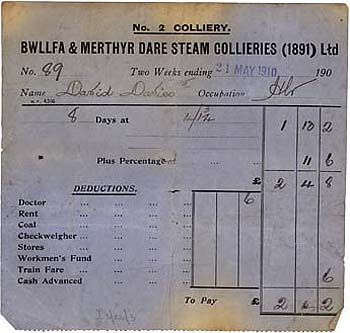 |
Nantmelin Colliery
- The last of the Cwmdare Collieries to be opened, Mordecai Jones of Brecon started work at the site in 1860 and the first coal was raised from the Four Feet Seam in April 1861. After Jones' death in 1880 the Nantmelin Colliery Company formed to run the company until in 1891 they amalgamated with the Aberdare Merthyr Collieries Co. Ltd. In 1896 the colliery was taken over by the expanding Bwllfa Company, the final private owners were the Powell Duffryn Company who took over all of the Bwllfa concerns in 1935. In 1949 the National Coal Board began work on a scheme to link up Cwmdare with the Rhondda Fach, which eventually lead to the closure of Nantmelin in 1957 when all coal was worked from Maerdy.
Roll the mouse over the image left to view the same scene today |
|
| Bwllfa Dare Colliery or just Bwllfa Colliery was sank at the head of the Cwmdare Valley under the shadow of the Darren by Samuel Thomas and Thomas Joseph in the early 1850's. Like many of the collieries, Bwllfa Dare passed through a number of owners during its lifetime. However, the history of Bwllfa Colliery is synonymous with two family names; The Brogden Family and, particularly, the Llewellyn Family. The Brogden Family connection with Bwllfa begins in the early 1870's when John Brogden & Sons bought the colliery from the Bwllfa Colliery Co. Ltd. The Brogden family retained its connections with the colliery until the death of John Brogden's youngest son G W H Brogden in 1892. Thereafter, it is Rees Llewellyn and his son D R Llewellyn who rose to prominence. Rees Llewellyn had been manager at Bwllfa since 1877 and by the beginning of the Twentieth Century he had become Chairman of the company running the colliery. During his leadership the colliery and its associated interests enjoyed their greatest period of prosperity. By 1906 The Bwllfa and Merthyr Dare Steam Coal Collieries (1891) Ltd. owned all the collieries in the Cwmdare Valley. D R Llewellyn, after showing his acumen by making a success of the Windber Levels, took over the Chairmanship of the company after his father's death in 1919. He retained ownership until the company was sold to Powell Duffryn in 1935. Both Rees and D R Llewellyn played an active part in public life in the Aberdare area, both serving on the Aberdare Urban District Council amongst other bodies. After nationalisation in 1947 the scheme to link Bwllfa and Maerdy collieries necessitated a redevelopment of the Bwllfa site and a new concrete head frame and winding house were constructed. However, in 1977 work stopped for the last time at Bwllfa and by 1991 the site had been completely cleared. |
|
| The collieries in the Cwmdare Valley were served by two railway lines operated by rival companies. The first line to reach the collieries was the Dare and Aman Branch of the Vale of Neath Railway, more familiarly known as the Great Western Railway after their takeover of the Vale of Neath in 1865, which reached Bwllfa Colliery in 1857. This railway reached Cwmdare from Gelli Tarw Junction near Llwydcoed after crossing the Gamlyn and Dare Viaducts, two fine examples of timber viaducts designed by Isambard Kingdom Brunel. The second line to Cwmdare was built by the Taff Vale Railway and followed a route near the River Dare from a junction close to Aberdare. This line was opened in 1866. The routes of both of these railways can still be traced, as they were adapted for use as a road and path when the Cwmdare Valley was redeveloped to create the Dare Valley Country Park. |
|
| Dare Valley Country Park - The Park was officially opened in December 1973. Work began in 1971 to reclaim the derelict land that had been deeply scarred by over a century of mining. The scheme involved the leveling of coal tips, the rerouting of the River Dare and the creation of two lakes with a cascade on the Dare down to the lower lake. In 1985 the visitor centre was opened, which has 15 rooms providing accommodation for guests. A campsite and small caravan park are also located near the visitor centre. | 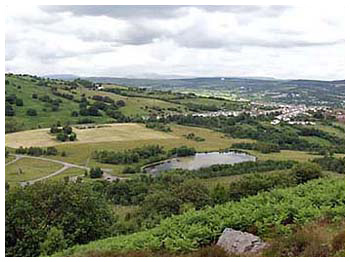 |
